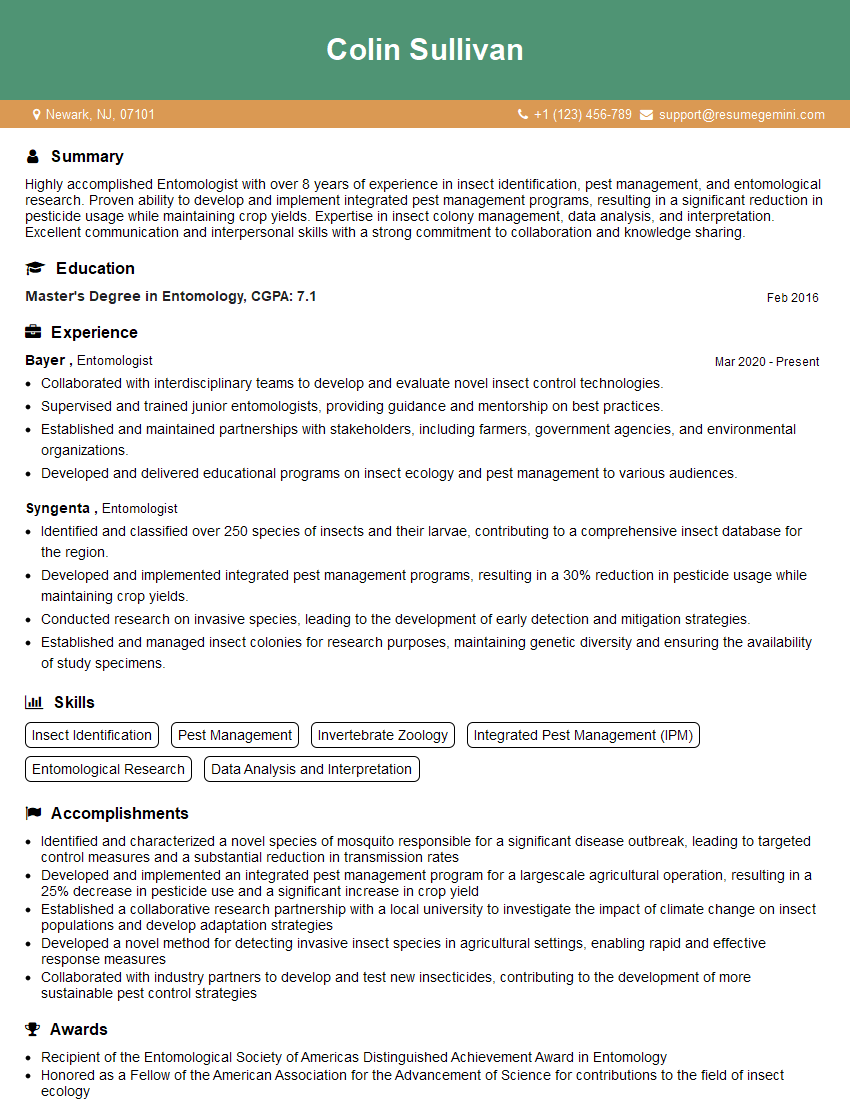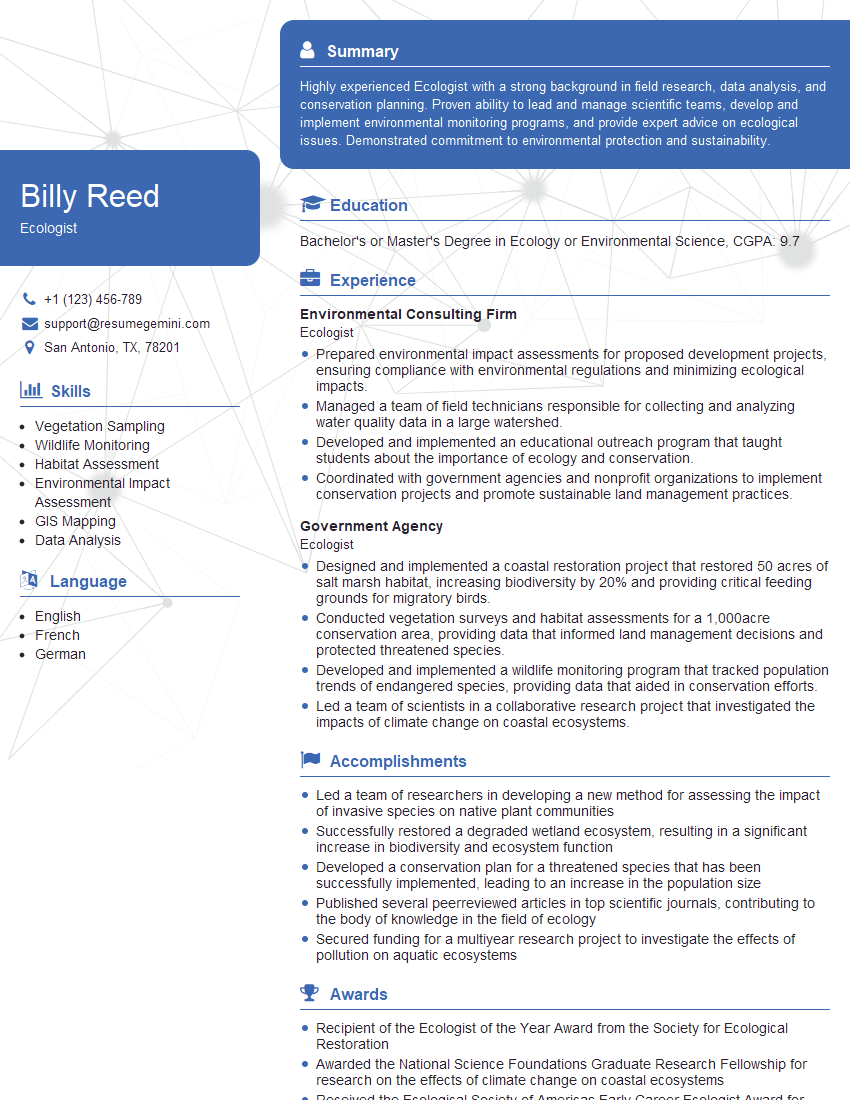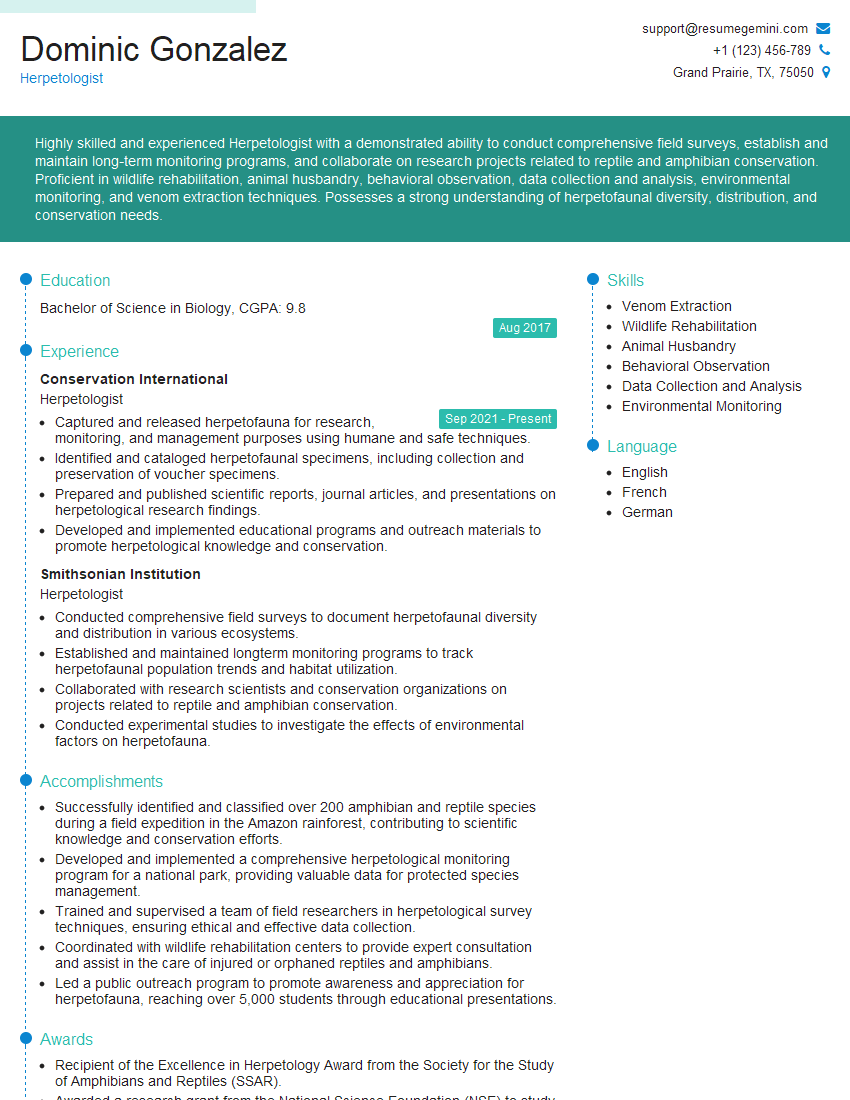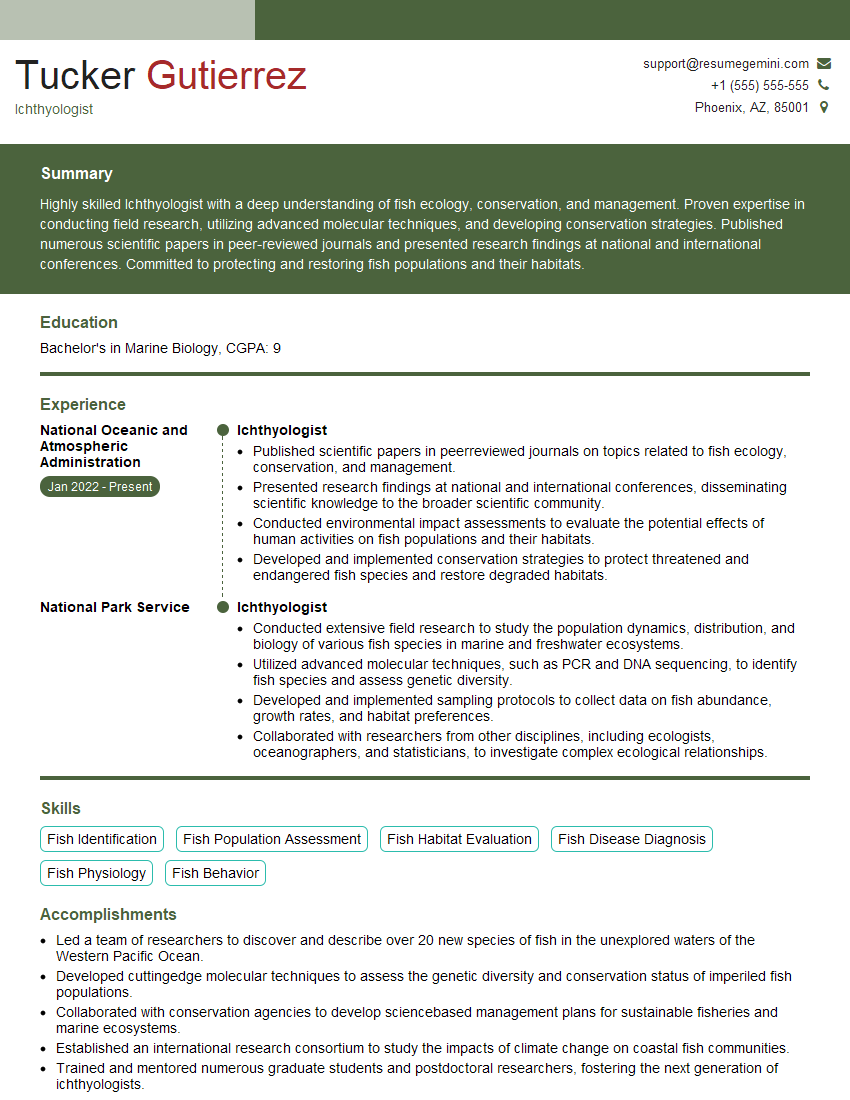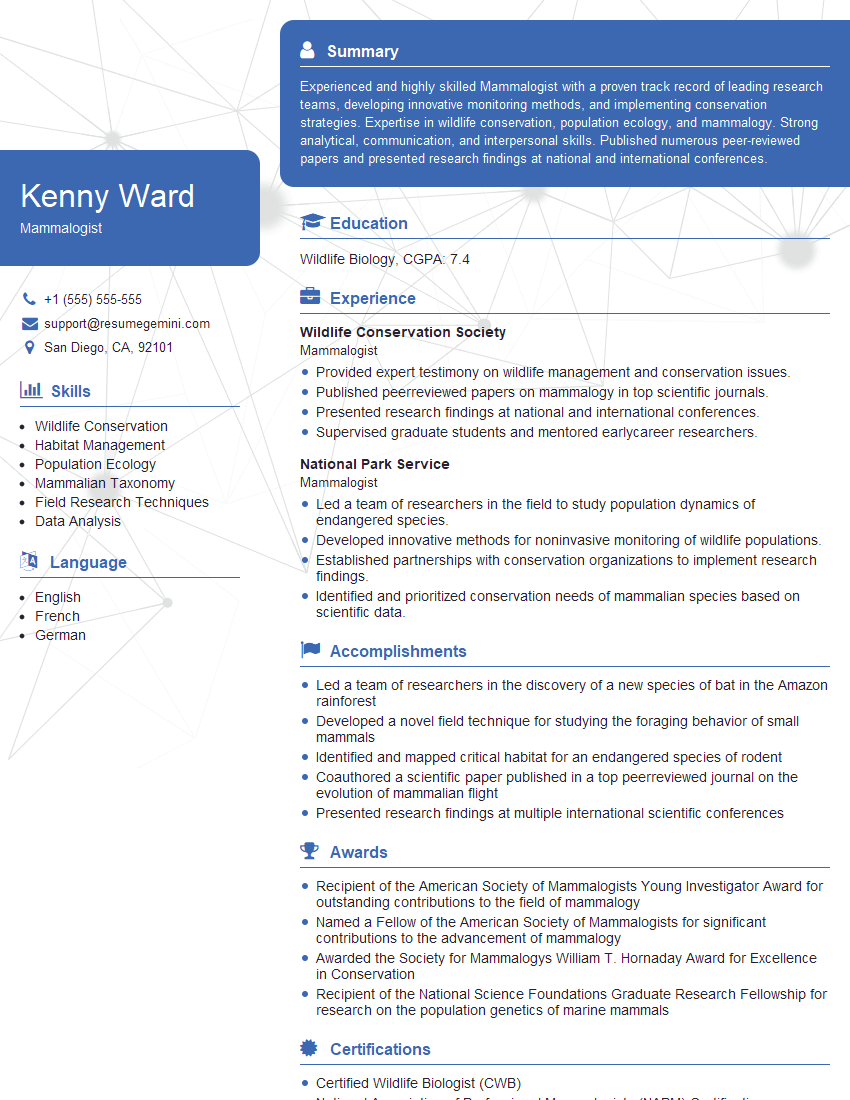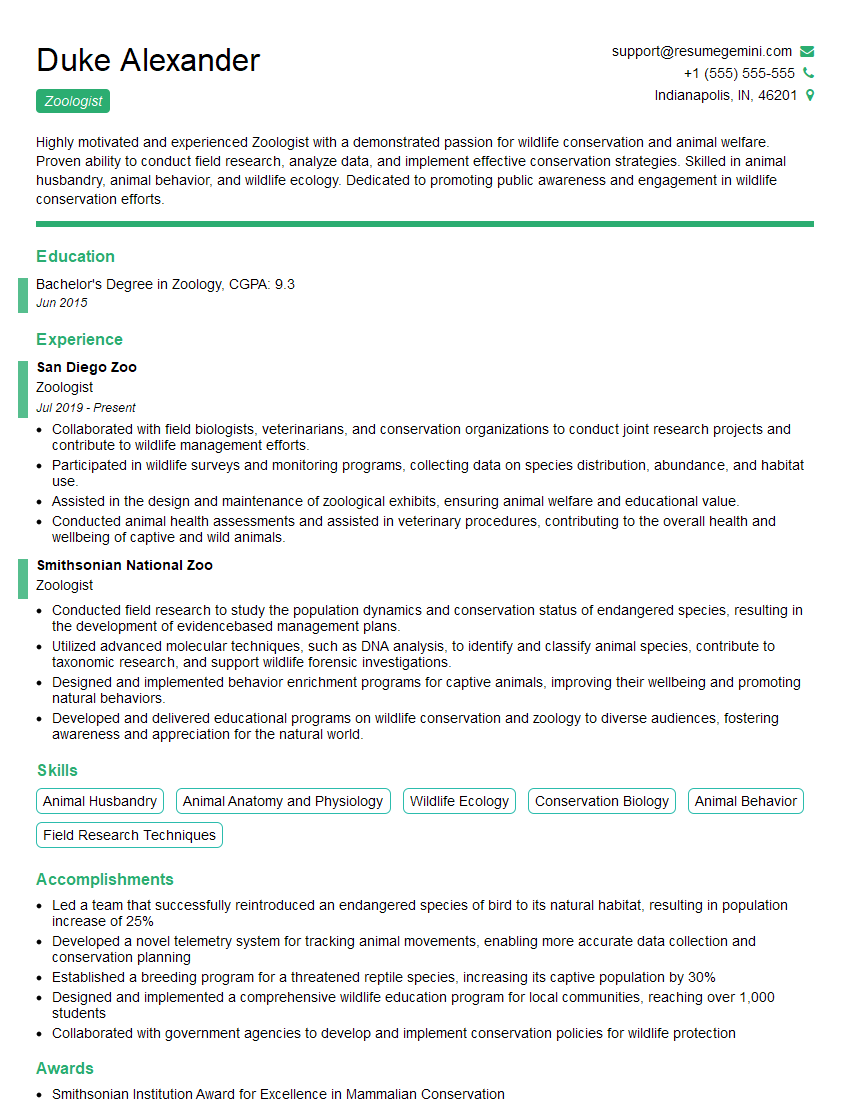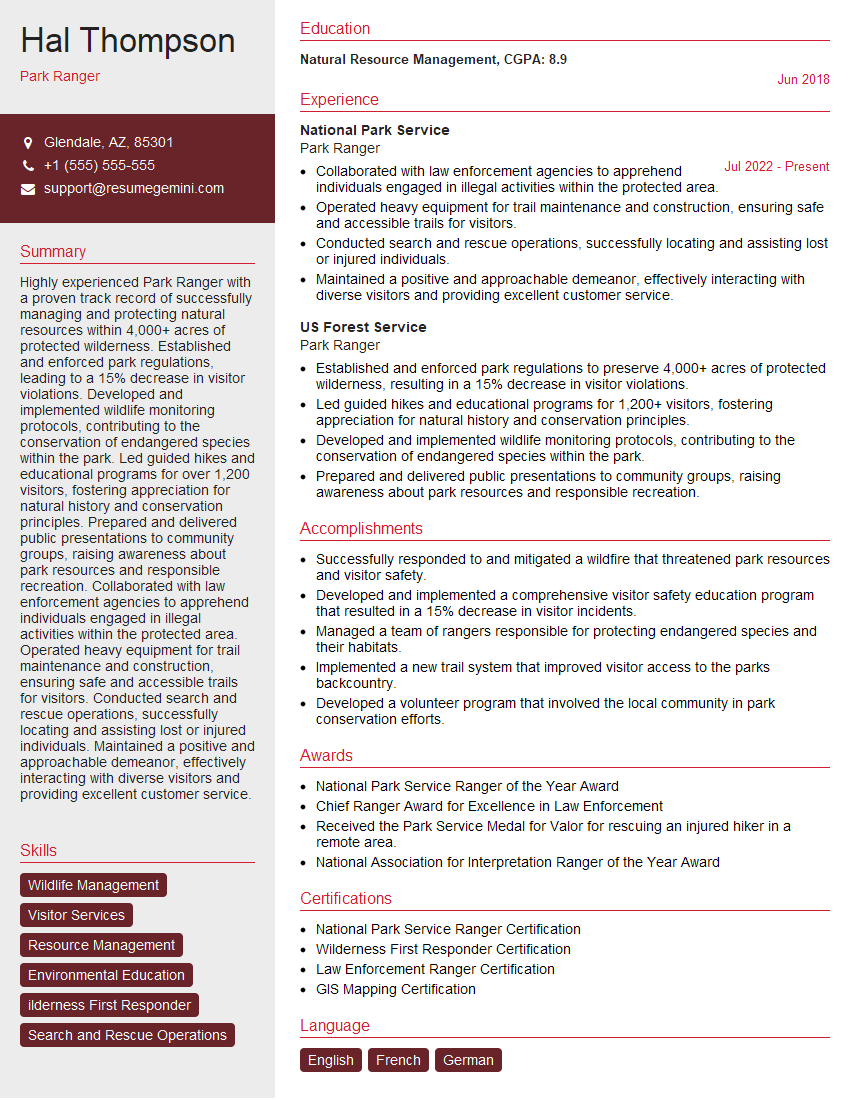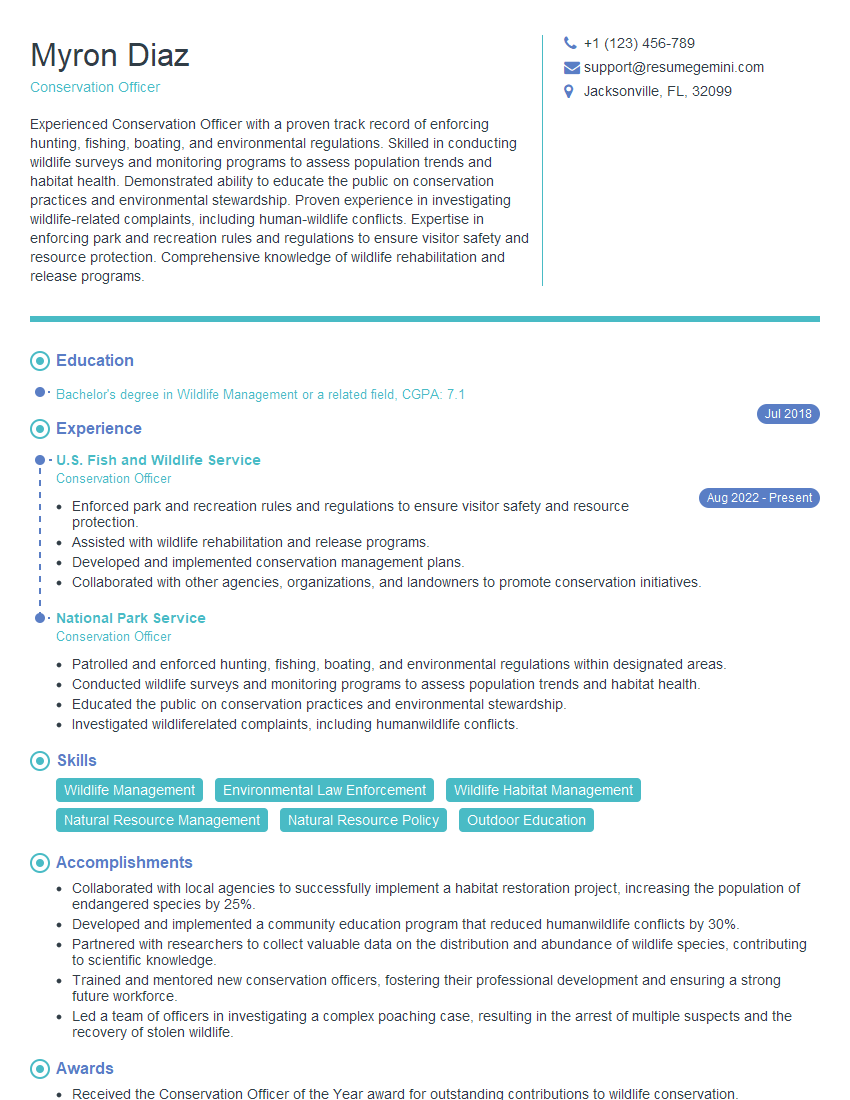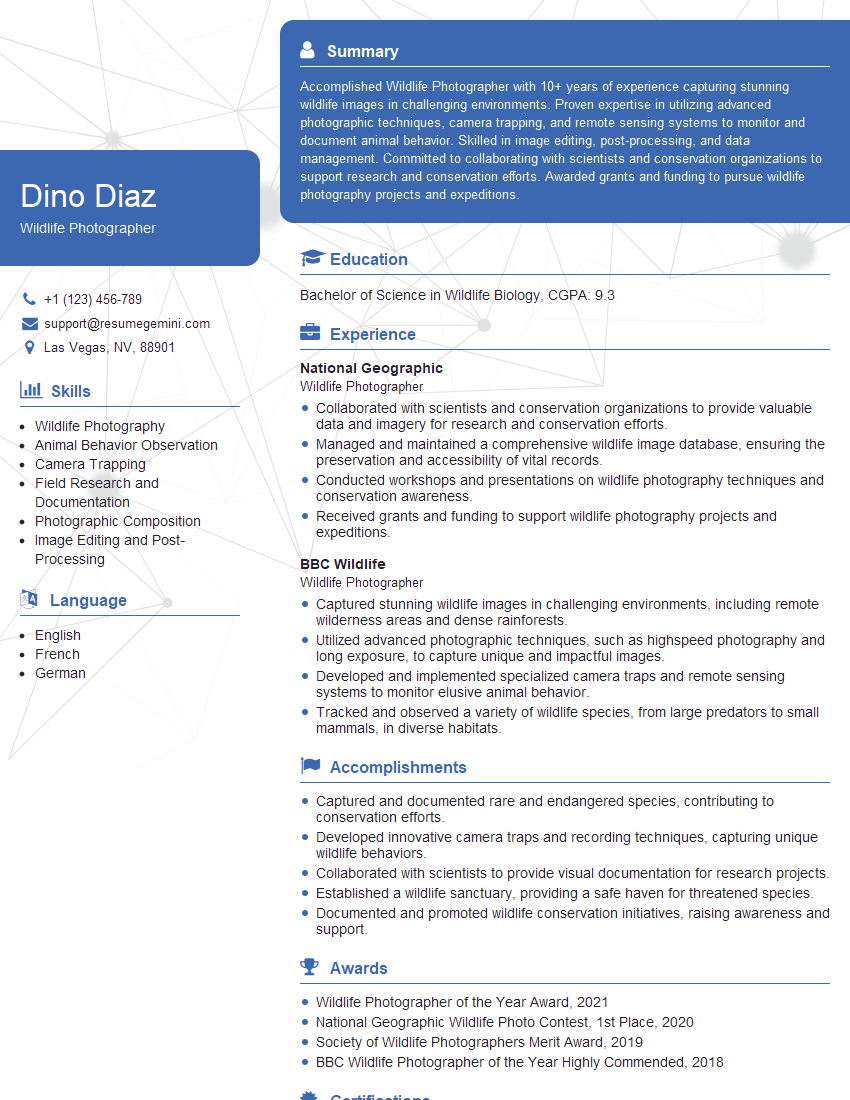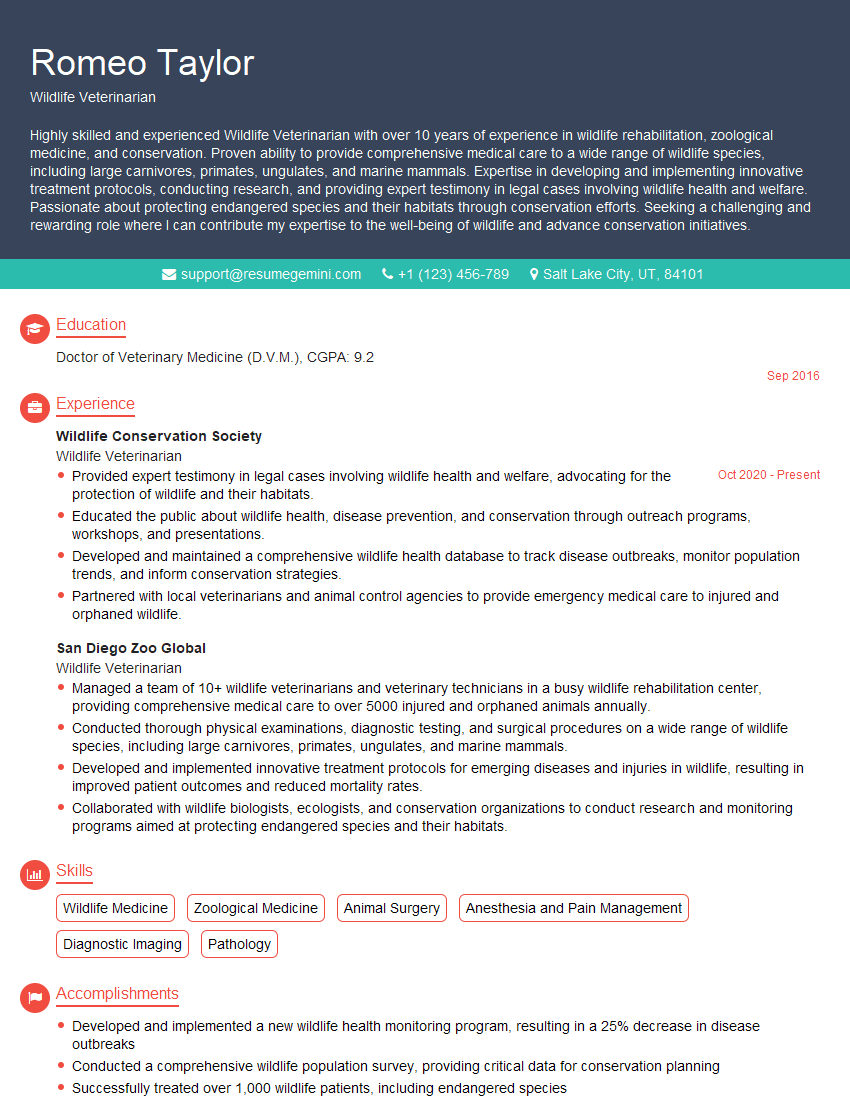The right preparation can turn an interview into an opportunity to showcase your expertise. This guide to Wildlife Identification and Education interview questions is your ultimate resource, providing key insights and tips to help you ace your responses and stand out as a top candidate.
Questions Asked in Wildlife Identification and Education Interview
Q 1. Describe the process of identifying a bird species using field guides and binoculars.
Identifying a bird species requires a systematic approach combining visual observation with reliable resources. First, you need good quality binoculars to get a clear view of the bird at a safe distance. Then, you’ll use a field guide, a book containing detailed descriptions and illustrations of various bird species in your region. The process usually involves these steps:
- Size and Shape: Note the bird’s overall size compared to familiar objects (e.g., a robin, a sparrow). Observe its body shape – is it slender, stocky, or long-necked?
- Plumage: Carefully observe the bird’s coloration and patterns. Note the color of its head, back, wings, breast, and tail. Look for distinct markings, such as stripes, spots, or bands.
- Behavior: How does the bird behave? Is it foraging on the ground, perching in trees, or flying in a particular pattern? What kind of sounds does it make?
- Habitat: Where did you observe the bird? Different bird species prefer different habitats (forests, wetlands, grasslands).
- Using the Field Guide: Once you’ve made these observations, consult your field guide. Many guides are organized by color, size, or habitat, making it easier to narrow down possibilities. Compare your observations to the descriptions and illustrations in the guide until you find a match. If uncertain, consider consulting multiple guides or online resources.
For example, if you see a small, brown bird with a short, slightly upturned bill foraging on the ground in a grassy field, you might suspect a sparrow. Consulting your field guide’s sparrow section would then allow you to distinguish between different sparrow species based on finer details like wing bars or breast markings.
Q 2. Explain the difference between habitat and niche.
While closely related, habitat and niche represent distinct ecological concepts. Habitat refers to the physical environment where an organism lives, including the biotic (living) and abiotic (non-living) factors. Think of it as the organism’s ‘address’. A bird’s habitat might be a forest, a wetland, or a desert.
Niche, on the other hand, describes the organism’s role and position within its ecosystem. It encompasses all aspects of its life, including its interactions with other organisms, its feeding habits, its reproductive strategies, and its tolerance to environmental conditions. Think of it as the organism’s ‘profession’. Two species can share a habitat but have different niches, for example, two bird species living in the same forest but feeding on different insects or at different heights in the trees. A niche is often described as an n-dimensional hypervolume, encompassing all the environmental factors impacting the organism’s survival and reproduction.
For instance, two species of warblers might share the same forest habitat (the address), but one might feed primarily on insects in the tree canopy while the other forages for insects on the forest floor. Their distinct feeding strategies represent their different niches (their professions).
Q 3. How do you assess the health of a wildlife population?
Assessing wildlife population health involves a multifaceted approach, combining various techniques to obtain a comprehensive picture. Key indicators include:
- Population Size and Density: Counting individuals directly (e.g., through visual surveys or mark-recapture studies) or indirectly (e.g., using scat analysis, tracks, or vocalizations) gives a measure of population size. Density indicates the number of individuals per unit area.
- Age Structure: Determining the proportion of young, adults, and old individuals provides insights into reproductive success and survival rates. An imbalanced age structure (e.g., few young) can signal problems.
- Body Condition: Measuring body weight, fat reserves, and overall physical condition can reveal the nutritional status and overall health of individuals. Malnutrition can point to habitat degradation or disease.
- Disease Prevalence: Monitoring the presence and spread of diseases through serological testing (blood tests) or necropsy (animal autopsies) can help assess the impact of pathogens on population health.
- Genetic Diversity: Low genetic diversity increases vulnerability to disease and environmental changes. Genetic analysis can help assess the level of genetic diversity within a population.
- Reproductive Success: Monitoring breeding rates (number of offspring produced), nest success, and juvenile survival rates are crucial indicators of reproductive health.
For example, a decline in population size coupled with a low proportion of young individuals and poor body condition could indicate habitat loss, increased predation, or disease, requiring further investigation and conservation intervention.
Q 4. What are the common methods used for wildlife tracking and monitoring?
Wildlife tracking and monitoring utilize various methods adapted to the specific species and research questions. Common techniques include:
- Visual Observation: Direct observation using binoculars or spotting scopes. This can be complemented by camera trapping (motion-activated cameras) for less observable species.
- Radio Telemetry: Attaching radio collars or transmitters to animals allows researchers to track their movements remotely. This provides valuable data on habitat use, migration patterns, and home range size.
- GPS Tracking: More advanced GPS collars provide precise location data, often relayed via satellite. This offers finer-scale information than radio telemetry.
- Acoustic Monitoring: Recording animal vocalizations (songs, calls) to identify species, estimate population size, and monitor their activity patterns. This is particularly useful for elusive species.
- Scat Analysis: Analyzing animal droppings to determine diet, identify parasites, and assess reproductive status (e.g., hormones in feces).
- Mark-Recapture Studies: Capturing, marking, and releasing animals, then recapturing them at a later date to estimate population size. Different marking techniques (tags, paint, etc.) are used depending on the species.
- DNA Analysis: Analyzing DNA from scat, hair, or other samples can be used for species identification, population genetic analysis, and individual identification.
The choice of method depends on factors like the species’ behavior, habitat, and the research objectives. For example, radio telemetry might be used to study the migration patterns of a large mammal, while acoustic monitoring could be employed to assess the distribution of a vocalizing bird species.
Q 5. List three common threats to biodiversity and explain their impact.
Three major threats to biodiversity are habitat loss, invasive species, and climate change. Their impacts are devastating and interconnected.
- Habitat Loss: Destruction, degradation, or fragmentation of habitats due to deforestation, urbanization, agriculture, and mining reduces the space available for wildlife, leading to population declines and extinctions. This is often the most significant threat, directly impacting the resources and space needed by species.
- Invasive Species: Non-native species introduced to new environments can outcompete native species for resources, prey on them, introduce diseases, or alter habitats. Invasive species can disrupt entire ecosystems, causing cascading effects throughout the food web. For instance, the introduction of the brown tree snake to Guam led to the extinction of several native bird species.
- Climate Change: Alterations in temperature, precipitation patterns, and sea levels are shifting species’ distributions, disrupting ecological interactions, and increasing the frequency of extreme weather events. This leads to habitat mismatch (species are unable to adapt to changed environments), phenological mismatches (timing of life cycle events are disrupted), and increased stress on organisms, impacting their survival and reproduction.
These threats often act synergistically, meaning their combined effect is greater than the sum of their individual impacts. For example, habitat loss can make species more vulnerable to climate change, and climate change can facilitate the spread of invasive species.
Q 6. Explain the importance of citizen science in wildlife conservation.
Citizen science plays a vital role in wildlife conservation by expanding the scope of data collection and monitoring efforts beyond the capacity of professional scientists. It empowers volunteers to participate in research projects, contributing valuable data and promoting greater public awareness and engagement.
Examples include:
- Species Monitoring: Volunteers can participate in bird counts, butterfly surveys, or amphibian monitoring programs, providing data on species distribution, abundance, and population trends.
- Data Collection for Conservation Efforts: Citizens can contribute to large-scale projects like tracking invasive species, monitoring habitat changes, or recording wildlife sightings.
- Increasing Public Awareness: Participation in citizen science projects raises awareness about wildlife issues and the importance of conservation, encouraging responsible environmental stewardship.
- Cost-Effective Data Gathering: Citizen science can substantially reduce the cost and effort associated with large-scale monitoring programs.
Citizen science initiatives, such as community-based wildlife monitoring programs or online platforms for reporting wildlife observations, empower individuals to directly contribute to conservation efforts, generating valuable data that can inform policy decisions and management strategies.
Q 7. Describe different approaches to wildlife rehabilitation.
Wildlife rehabilitation aims to restore injured, sick, or orphaned animals to health and release them back into their natural habitats. Approaches vary depending on the species, the nature of the injury or illness, and the availability of resources.
Different approaches include:
- Immediate First Aid and Stabilization: This initial phase focuses on addressing life-threatening injuries, providing warmth, fluids, and pain relief.
- Veterinary Care: Veterinarians play a critical role in diagnosing illnesses, treating injuries, and providing necessary medical interventions (e.g., surgery, medication).
- Specialized Care Facilities: Many rehabilitation centers specialize in particular animal groups or types of injuries. These facilities offer appropriate housing, diet, and enrichment tailored to the species’ needs.
- Behavioral Enrichment: Providing stimuli and opportunities for natural behaviors (e.g., foraging, climbing, swimming) is crucial for maintaining physical and psychological well-being.
- Soft Release Programs: Gradually introducing animals back into the wild, allowing them to adjust to their natural environment before complete release, improves their survival chances.
- Habitat Assessment and Monitoring: Before releasing an animal, assessing the habitat to ensure it is suitable and monitoring the animal post-release to evaluate its success are important steps.
Ethical considerations are paramount in wildlife rehabilitation. Prioritizing the animal’s welfare, minimizing human interaction, and ensuring a high chance of successful release are essential. Rehabilitation is not always successful, but when done effectively, it plays a crucial role in preserving biodiversity.
Q 8. How do you handle a potentially dangerous wildlife encounter?
Encountering potentially dangerous wildlife requires a calm and cautious approach. The first rule is prevention; understanding animal behavior and habitat helps avoid encounters altogether. Knowing the typical range and activity patterns of animals in a given area is crucial. For example, hiking in areas known for bear activity at dawn or dusk increases the risk.
If an encounter occurs, the key is to remain calm and avoid sudden movements. These actions can trigger a defensive response. Slowly back away, giving the animal a wide berth. Never approach or attempt to feed wildlife. Making yourself appear larger (raising your arms) can sometimes deter an animal. Carry bear spray or other appropriate deterrents in bear or other predator country, but only use it as a last resort and according to manufacturer instructions. If attacked, fight back aggressively, aiming for vulnerable areas like eyes and nose.
After the encounter, report the incident to the relevant wildlife authorities. This data contributes to better understanding animal behavior and informs future safety measures. Always remember that your safety and the animal’s well-being are paramount. Never put yourself or others at unnecessary risk.
Q 9. What are the ethical considerations in wildlife research?
Ethical wildlife research centers around minimizing harm to animals and their environments. Key considerations include obtaining necessary permits and adhering to strict protocols. This involves rigorous research design, ensuring that the research questions are justified and that methods chosen cause minimal stress or disturbance. The principle of ‘do no harm’ is paramount.
Another crucial aspect is ensuring animal welfare. Research must adhere to guidelines set by organizations such as the IACUC (Institutional Animal Care and Use Committee) which evaluate the ethical implications of research involving animals. Data collected must be used responsibly and findings disseminated in a way that contributes to conservation efforts, rather than contributing to exploitation.
Finally, ethical research must consider the broader ecological context. Impacts on the entire ecosystem, not just the target species, must be assessed and mitigated whenever possible. This includes respecting indigenous knowledge and involving local communities in the research process, acknowledging their rights and traditional practices.
Q 10. Explain the concept of keystone species and provide an example.
A keystone species is an organism that has a disproportionately large effect on its environment relative to its abundance. The removal of a keystone species can trigger dramatic changes in the ecosystem structure and function, impacting many other species. They are vital for maintaining biodiversity.
A classic example is the sea otter in kelp forests. Sea otters feed primarily on sea urchins, which are herbivores that consume kelp. Without sea otters, the sea urchin population explodes, leading to overgrazing of kelp forests. This loss of kelp drastically alters the habitat, affecting countless other species that depend on it for shelter and food.
Other examples include wolves in Yellowstone National Park, whose reintroduction controlled elk populations and subsequently impacted vegetation, river systems, and other wildlife. The concept of keystone species highlights the interconnectedness of ecosystems and the critical role even seemingly minor players can have.
Q 11. Discuss the role of education in wildlife conservation.
Education plays a vital role in wildlife conservation by fostering awareness, changing attitudes, and promoting responsible behaviors. Effective wildlife education programs instill a sense of wonder and respect for nature in individuals, leading to greater support for conservation efforts.
Education can take many forms, including formal classroom settings, public outreach programs at zoos and museums, citizen science initiatives, and informal learning through nature documentaries and online resources. Successful programs utilize interactive and engaging methods such as hands-on activities, field trips, and storytelling to connect with audiences emotionally.
By promoting understanding of ecological concepts such as biodiversity, habitat loss, and climate change, education equips people with the knowledge necessary to make informed decisions regarding their environmental impact. This includes reducing waste, conserving water and energy, supporting sustainable practices, and advocating for responsible policies.
Q 12. How do you adapt your communication style to different audiences (children, adults, experts)?
Adapting my communication style to different audiences is crucial for effective wildlife education. When working with children, I employ simple language, engaging visuals, and hands-on activities. I use stories and analogies to make complex concepts relatable, focusing on creating a fun and memorable experience.
When communicating with adults, I can use more technical vocabulary and delve into greater detail, providing scientific background and discussing conservation challenges and solutions. I encourage questions and facilitate discussions, aiming to foster critical thinking and engagement.
When interacting with experts, I focus on sharing research findings, discussing the latest scientific advancements, and engaging in a peer-to-peer exchange of knowledge. The conversation becomes more technical and in-depth, focusing on nuanced aspects of specific research areas. I use this opportunity for collaboration and knowledge exchange.
Q 13. Describe a successful wildlife education program you’ve been involved in.
One successful wildlife education program I was involved in was a community-based initiative focused on conserving the local bird population. We partnered with local schools, community centers, and environmental organizations to develop a multifaceted program. This included classroom presentations on bird identification and habitat conservation, guided bird walks and surveys, and the creation of birdhouses and feeders.
The program involved hands-on activities like building nesting boxes and participating in citizen science projects, fostering a sense of ownership and responsibility among participants. We used social media to share updates, photos, and videos, engaging a wider audience. The program increased awareness of local bird species, their habitat requirements, and the threats they face. We also observed a significant increase in community involvement in conservation efforts.
The success was measured by increased participation in bird surveys, a noticeable increase in the number of nesting boxes adopted, and an improved understanding of bird conservation among community members.
Q 14. What are the key elements of a successful wildlife management plan?
A successful wildlife management plan requires a multi-faceted approach combining scientific data, community involvement, and adaptive management strategies. Key elements include:
- Clear Objectives and Goals: Defining specific, measurable, achievable, relevant, and time-bound (SMART) goals for the plan. For example, increasing the population of a threatened species by a certain percentage within a defined timeframe.
- Population Monitoring: Regular monitoring of the target species using various techniques such as surveys, tagging, and remote sensing to assess population size, distribution, and health.
- Habitat Management: Protecting and restoring critical habitats through activities like habitat restoration, invasive species control, and fire management.
- Community Engagement: Involving local communities and stakeholders in the planning and implementation process through workshops, public forums, and collaborative decision-making.
- Adaptive Management: Regularly evaluating the effectiveness of the plan, adapting strategies based on monitoring data, and incorporating new scientific knowledge.
- Enforcement and Regulation: Implementing and enforcing regulations to protect the target species and their habitats, such as hunting restrictions or habitat protection laws.
- Funding and Resources: Securing adequate funding and resources to support the implementation of the plan.
Successful wildlife management requires a long-term perspective, recognizing that ecological systems are dynamic and require continuous adaptation and monitoring.
Q 15. How do you use technology (GPS, GIS, etc.) in wildlife identification and monitoring?
Technology plays a crucial role in modern wildlife identification and monitoring. GPS (Global Positioning System) and GIS (Geographic Information System) are invaluable tools. GPS allows us to track animal movements precisely, recording their location over time. This data provides insights into habitat use, migration patterns, and home range sizes. For example, we might attach GPS collars to wolves to understand their hunting strategies and territorial behavior.
GIS takes this a step further, allowing us to visualize this location data on maps alongside other relevant information, such as vegetation types, elevation, and human infrastructure. We can then analyze spatial relationships between wildlife movements and environmental factors. Imagine overlaying wolf movement data onto a map showing forest fragmentation; this analysis can highlight areas vulnerable to habitat loss. Other technologies like camera traps, equipped with GPS, provide visual data that can be georeferenced in a GIS, increasing the richness of our datasets.
Career Expert Tips:
- Ace those interviews! Prepare effectively by reviewing the Top 50 Most Common Interview Questions on ResumeGemini.
- Navigate your job search with confidence! Explore a wide range of Career Tips on ResumeGemini. Learn about common challenges and recommendations to overcome them.
- Craft the perfect resume! Master the Art of Resume Writing with ResumeGemini’s guide. Showcase your unique qualifications and achievements effectively.
- Don’t miss out on holiday savings! Build your dream resume with ResumeGemini’s ATS optimized templates.
Q 16. What is your experience with data collection and analysis in wildlife studies?
My experience with data collection and analysis in wildlife studies is extensive. I’ve been involved in numerous projects, from small-scale population surveys to large-scale landscape ecology studies. Data collection methods vary depending on the species and research question. This includes direct observation, mark-recapture studies (like tagging birds), camera trapping (mentioned above), scat analysis (identifying species via their droppings), and acoustic monitoring (recording animal vocalizations).
Data analysis involves statistical techniques tailored to the type of data. For example, population estimates often require specialized models like capture-mark-recapture analysis, while habitat use analysis might involve resource selection functions or spatial point pattern analysis. I’m proficient in various statistical software packages like R and ArcGIS, allowing me to perform complex analyses and create informative visualizations to communicate my findings effectively.
Q 17. Explain different methods of wildlife population estimation.
Wildlife population estimation employs various methods, each with its strengths and limitations. A fundamental method is the complete count, which involves counting every individual in a population. This is only feasible for small, easily observable populations. For larger populations, we rely on sampling techniques.
- Mark-recapture is a common approach where a sample of animals is captured, marked, and released. Later, another sample is captured, and the proportion of marked individuals helps estimate the total population size. It’s like baking cookies and marking some; then, checking the proportion of marked cookies in a second batch gives an estimate of the total number baked.
- Distance sampling estimates abundance based on the distances between observed animals and the observer. This method is used for animals that are easily spotted but not easily counted, like whales.
- Line transect sampling is a variation of distance sampling, where observations are recorded along a predefined line.
- Indices of abundance are indirect measures, like the number of nests or tracks, which are correlated with population size. These are useful when direct counting is impossible but require careful calibration and consideration of potential biases.
The choice of method depends heavily on the species’ characteristics, habitat, and available resources.
Q 18. Describe your knowledge of specific endangered or threatened species in your region.
In my region, the Florida panther (Puma concolor coryi) is a critically endangered species. Habitat loss due to urban sprawl and road mortality are major threats. I’ve been involved in projects assessing panther habitat connectivity, using GIS to identify potential wildlife corridors. Another species of concern is the gopher tortoise (Gopherus polyphemus), a keystone species whose burrows provide habitat for many other animals. Their populations are threatened by habitat destruction and urbanization. My work has included assessing the impact of development on tortoise populations and developing mitigation strategies.
Q 19. How would you address a conflict between humans and wildlife?
Addressing human-wildlife conflict requires a multi-pronged approach focusing on both mitigation and education. This often begins with identifying the root cause of the conflict. Is it habitat encroachment? Lack of waste disposal? Attractive food sources?
Mitigation strategies might include installing fencing to keep wildlife away from human settlements, providing alternative food sources (e.g., bird feeders away from houses), or implementing hazing techniques (non-lethal deterrents) to modify animal behavior. Education is crucial; educating local communities about wildlife behavior, coexistence strategies, and the importance of habitat conservation is paramount. For instance, a community workshop on bear-resistant trash cans could drastically reduce human-bear conflicts.
Q 20. What are the legal regulations surrounding wildlife in your area?
Wildlife regulations in my area (assuming Florida, given the panther example) are complex and enforced at both state and federal levels. The Florida Fish and Wildlife Conservation Commission (FWC) is the primary state agency responsible for managing wildlife. Federal laws, such as the Endangered Species Act (ESA), also play a significant role. Specific regulations cover hunting seasons, permits for wildlife observation or research, and penalties for harming or possessing protected species. There are strict guidelines around habitat conservation and development permits in sensitive areas. Keeping abreast of these laws and regulations is crucial for responsible wildlife management and research.
Q 21. How do you stay current with advances in wildlife identification and conservation techniques?
Staying current in wildlife identification and conservation requires ongoing professional development. I regularly attend conferences and workshops to learn about the latest techniques and technologies. I actively participate in professional organizations like the Wildlife Society, which provide access to peer-reviewed journals, webinars, and networking opportunities. I also utilize online databases and resources to stay updated on new research findings, conservation strategies, and policy changes. Continuous learning is essential in this rapidly evolving field.
Q 22. Describe your experience with working in diverse teams and collaboration.
Throughout my career, I’ve thrived in collaborative environments, working effectively with diverse teams composed of scientists, educators, park rangers, and volunteers. For instance, during a recent biodiversity survey in the Amazon rainforest, our team, which included botanists, ornithologists, and local indigenous guides, successfully collaborated to document several previously unknown species. Each member brought unique expertise and perspectives, fostering a rich exchange of knowledge and leading to a more comprehensive data set. My role involved coordinating data collection, ensuring everyone’s contributions were integrated effectively, and mediating any disagreements regarding research methodologies. This project underscored the importance of open communication, mutual respect, and a shared commitment to the project’s goals in achieving success in a diverse team setting.
In another instance, I worked on a community-based wildlife education program, collaborating with teachers, community leaders, and parents. This required tailoring educational materials to various learning styles and cultural backgrounds, demanding strong interpersonal skills and a collaborative approach to program design and implementation. The successful outcome demonstrates my ability to build consensus, address diverse needs, and work effectively across different professional and cultural boundaries.
Q 23. How do you deal with setbacks or unexpected challenges in field work?
Fieldwork invariably presents unexpected challenges. For example, during a wildlife tracking expedition in the Alaskan wilderness, a sudden blizzard forced us to abandon our planned route and seek emergency shelter. This required quick thinking and decisive action. We assessed the situation, prioritized safety, established a temporary shelter, and rationed our supplies. Instead of getting discouraged, the team used the delay to further bond and hone their problem-solving skills. Learning to adapt to unexpected circumstances is crucial in this field.
Another challenge involves equipment malfunction. On a bird banding project, our mist nets were damaged in a storm. We quickly assessed the damage, repaired what we could, and improvised using available materials to continue the project, albeit at a slightly slower pace. This situation highlighted the importance of problem-solving, resourcefulness, and the ability to remain flexible in the face of setbacks. I always emphasize preparedness and contingency planning in field work to minimize the impact of unforeseen circumstances.
Q 24. What are your strengths and weaknesses in terms of wildlife identification and education?
My strengths lie in my extensive knowledge of wildlife identification, particularly within the avian and mammalian realms. Years of field experience and academic study have provided me with a deep understanding of animal behavior, ecology, and taxonomy. I can confidently identify numerous species across diverse habitats, utilizing both visual cues and auditory characteristics. Moreover, my ability to translate complex scientific information into engaging and accessible educational materials is a significant asset.
A potential area for development is expanding my expertise in herpetofauna (reptiles and amphibians) identification. While I possess a foundational understanding, I am actively seeking opportunities to enhance my proficiency in this area. I believe continued learning and practical experience will strengthen this aspect of my expertise. Another area for growth is incorporating innovative technologies, like augmented reality apps, into my educational programs to increase engagement and learning effectiveness.
Q 25. What are your long-term career goals in this field?
My long-term career goal is to contribute significantly to wildlife conservation and education. I aspire to lead impactful research projects that address critical conservation challenges, such as habitat loss and climate change. Simultaneously, I wish to develop and implement innovative educational initiatives to foster environmental stewardship and promote responsible wildlife interactions among diverse communities. I envision myself mentoring future generations of conservationists and contributing to policy-level changes that ensure the long-term survival of wildlife and their habitats.
Specifically, I am interested in establishing a community-based conservation center focused on research, education, and wildlife rehabilitation. This center will serve as a hub for collaboration between scientists, educators, and local communities, creating a sustainable model for conservation and education.
Q 26. Describe a situation where you had to make a difficult decision related to wildlife.
During a wildlife rescue operation, we found an orphaned wolf pup. The decision to intervene was difficult. Releasing it back into the wild immediately presented a high risk of mortality due to its vulnerability. However, human intervention could also negatively impact its development and natural behaviors. After consulting with wildlife experts, considering the pup’s health, and assessing the possibility of successful reintroduction, we opted for a carefully managed rehabilitation program in a specialized facility. This involved rigorous monitoring, gradual socialization, and eventual release back into a suitable habitat with long-term monitoring to track its survival and adaptation. This decision highlighted the ethical complexities of wildlife management and underscored the necessity of data-driven and collaborative decision-making in such scenarios.
Q 27. What is your experience with public speaking and presentations?
I have extensive experience in public speaking and presentations, regularly delivering lectures, workshops, and guided nature walks to diverse audiences. I’ve presented research findings at scientific conferences, given educational talks to school children, and led interpretive programs for visitors at nature centers. I am comfortable adapting my communication style to suit different audiences, using clear and concise language, visuals, and interactive elements to maximize understanding and engagement. My goal is always to create a memorable and impactful learning experience for everyone.
I am adept at using various presentation technologies, from traditional slide shows to interactive multimedia presentations. I am comfortable fielding questions from the audience and tailoring my presentations based on their interests and level of prior knowledge.
Q 28. How would you handle a situation where a member of the public is interacting inappropriately with wildlife?
If a member of the public were interacting inappropriately with wildlife, my approach would be educational and firm. First, I would approach the situation calmly and respectfully, explaining the potential dangers of such interactions for both the person and the animal. For instance, feeding wild animals can lead to habituation, making them reliant on humans and reducing their survival skills. Touching or getting too close can stress wildlife, leading to aggression or disease transmission. I would emphasize the importance of maintaining a safe and respectful distance.
If the person continues to act inappropriately despite my explanation, I would involve park rangers or other relevant authorities to ensure both the safety of the individual and the protection of the wildlife. The goal isn’t to be punitive, but rather to educate and enforce responsible wildlife viewing guidelines to ensure the long-term well-being of both humans and animals.
Key Topics to Learn for Wildlife Identification and Education Interview
- Wildlife Identification Techniques: Mastering visual identification (sight, sound, track, scat), understanding taxonomic classifications, and utilizing field guides and technology for species recognition.
- Ecological Principles: Demonstrating knowledge of animal behavior, habitat requirements, trophic levels, and ecosystem dynamics. This is crucial for understanding the context of wildlife within their environment.
- Educational Strategies and Program Development: Familiarize yourself with diverse teaching methodologies (interactive presentations, guided nature walks, educational games) and curriculum design for different age groups and learning styles.
- Conservation and Management: Understanding current conservation challenges, wildlife management strategies, and the role of education in promoting responsible wildlife stewardship.
- Communication and Public Engagement: Developing effective communication skills to engage diverse audiences, adapting your message for varying levels of ecological understanding, and conveying information clearly and enthusiastically.
- Ethical Considerations in Wildlife Education: Understanding the responsible and ethical handling of wildlife, minimizing disturbance to animals, and promoting respectful interactions between humans and wildlife.
- Problem-Solving in Wildlife Encounters: Practice thinking through scenarios involving unexpected wildlife behavior, potential conflicts between humans and wildlife, and safe response strategies.
- Data Collection and Interpretation: Gaining familiarity with data collection methods used in wildlife monitoring, understanding basic statistical analysis, and interpreting data to inform educational programs or conservation efforts.
Next Steps
Mastering Wildlife Identification and Education opens doors to a fulfilling career involving conservation, education, and community engagement. To maximize your job prospects, crafting a compelling and ATS-friendly resume is essential. This will showcase your skills and experience effectively to recruiters and hiring managers. We highly recommend using ResumeGemini, a trusted resource, to build a professional resume that highlights your unique qualifications in this field. ResumeGemini provides examples of resumes tailored specifically to Wildlife Identification and Education, ensuring your application stands out from the competition. Invest time in perfecting your resume; it’s your first impression.
Explore more articles
Users Rating of Our Blogs
Share Your Experience
We value your feedback! Please rate our content and share your thoughts (optional).
What Readers Say About Our Blog
Hi, I’m Jay, we have a few potential clients that are interested in your services, thought you might be a good fit. I’d love to talk about the details, when do you have time to talk?
Best,
Jay
Founder | CEO


